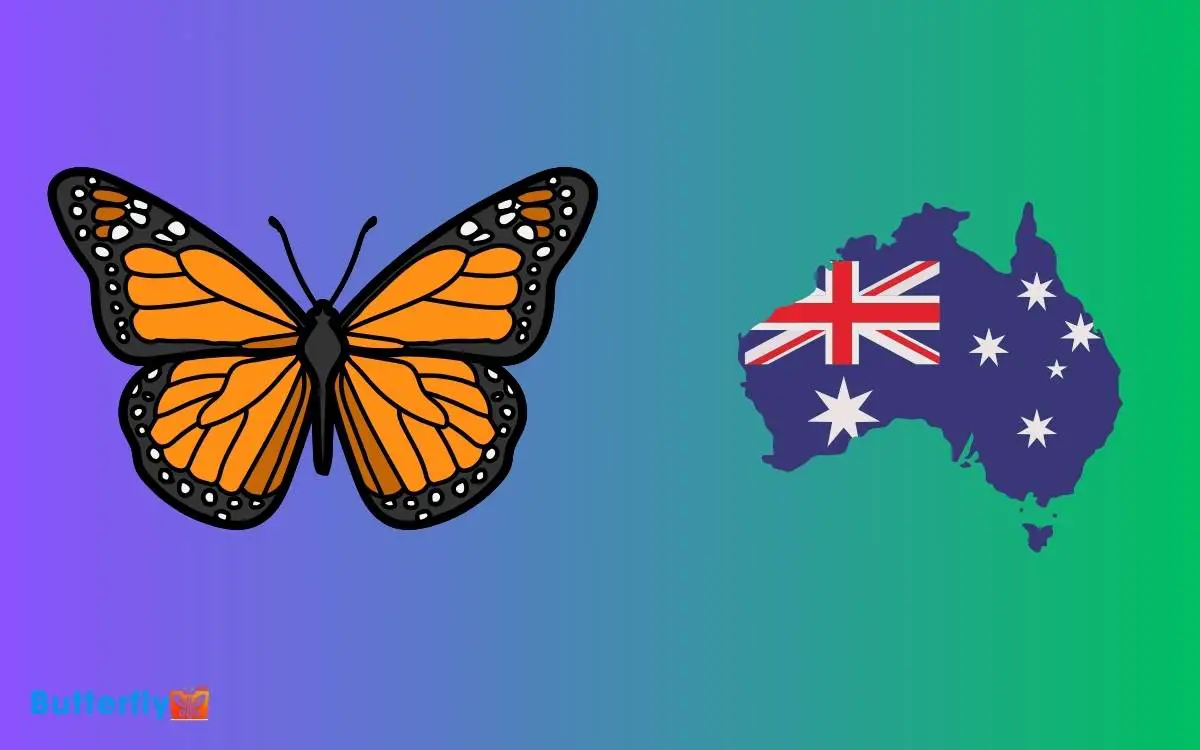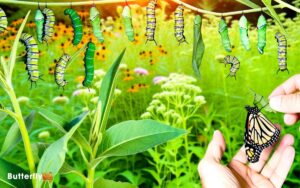Are Monarch Butterflies in Australia? Yes!
Yes, Monarch butterflies (Danaus plexippus) are indeed in Australia. They first arrived in the late 19th century, likely by natural dispersal.
These butterflies flourish along Australia’s eastern seaboard, particularly in Queensland, New South Wales, and Victoria.
Monarchs adapt to Australia’s climate via behavioral thermoregulation and specific milkweed host plant selection.
They follow particular migration and breeding patterns influenced by local climatic conditions. Threats to their survival include rising temperatures, predation, and habitat loss.
Conservation efforts like habitat restoration and milkweed planting are essential. To grasp how these ecological dynamics support their life cycle, you’d find more fascinating details ahead.

Key Takeaways
Historical Arrival
Arriving in the late 19th century, the monarch butterflies‘ introduction to Australia marks a significant event in the country’s entomological history.
You’ll find that these butterflies, scientifically known as Danaus plexippus, were first recorded in the 1870s. Their arrival likely resulted from natural dispersal across the Pacific Ocean, facilitated by favorable wind patterns and their robust migratory capabilities.
Observing their adaptation, you’ll see how they exploited the local milkweed (Asclepias spp.), essential for their larval stage.
This event not only expanded their geographical range but also provided an opportunity to study their remarkable migratory behavior and ecological interactions in a new environment.
Distribution in Australia
You’ll find monarch butterflies primarily along the eastern seaboard of Australia, where they thrive in the temperate and subtropical climates. They’re particularly abundant in Queensland, New South Wales, and Victoria.
These regions provide the essential conditions for their life cycle, including the presence of milkweed plants (Asclepias spp.), which are vital for larval development.
You can observe their populations in urban gardens, coastal areas, and open woodlands. Their distribution is often influenced by climatic factors, such as temperature and humidity, which affect their breeding and migratory patterns.
Additionally, the availability of nectar sources, like flowering plants, plays a significant role in sustaining adult monarchs.
Understanding these distribution patterns helps in conservation efforts and predicting population changes.
Adaptation Strategies
To understand how monarch butterflies thrive in Australia, you must examine their climate tolerance mechanisms. These mechanisms enable them to survive varying temperatures.
Additionally, observe their strategic selection of host plants. This impacts their reproduction and larval development.
Lastly, consider their migration pattern adaptations. These are essential for traversing Australia’s distinct ecological zones.
Climate Tolerance Mechanisms
Moreover, monarch butterflies in Australia exhibit remarkable adaptation strategies to tolerate varying climatic conditions, including behavioral thermoregulation and physiological adjustments.
You’ll notice they often sunbathe, positioning their wings to maximize solar absorption, which raises their body temperature on cooler days. Moreover, they migrate to warmer areas during winter, demonstrating behavioral plasticity.
Physiologically, these butterflies can alter their metabolic rate to conserve energy under adverse conditions. Hemolymph antifreeze proteins are synthesized to prevent cellular damage during unexpected cold spells.
Additionally, the monarchs’ ability to enter a state of diapause allows them to survive periods of unfavorable weather. These mechanisms collectively enhance their resilience, ensuring survival across Australia’s diverse environments.
Host Plant Selection
When selecting host plants, monarch butterflies in Australia exhibit a preference for specific milkweed species.
They primarily choose Asclepias curassavica, also known as tropical milkweed, due to its high cardenolide concentration. This toxic compound deters predators, providing a protective advantage to the larvae.
They also utilize Gomphocarpus fruticosus, or narrow-leaved cotton bush, which offers similar defensive properties.
Migration Patterns Adaptation
Leveraging their host plant preferences, monarch butterflies in Australia also exhibit remarkable flexibility in their migration patterns to adapt to the continent’s unique climatic conditions.
You’ll notice that unlike their North American counterparts, Australian monarchs don’t undertake long-distance migrations. Instead, they engage in localized movements, primarily driven by temperature fluctuations and resource availability.
During cooler months, they seek out warmer microhabitats, often clustering in coastal regions to avoid extreme inland temperatures. Additionally, their reproductive cycles are synchronized with the seasonal availability of milkweed, their primary larval host plant.
This adaptive behavior helps monarch populations maintain resilience against environmental stressors, enhancing their survival rates. By studying these patterns, you can gain insights into their adaptive strategies and ecological resilience.
Breeding Habits
You’ll observe that monarch butterflies in Australia exhibit intricate mating rituals, often involving aerial displays and pheromone exchanges.
The larvae primarily rely on specific host plants, such as milkweed, for nourishment and development.
Seasonal breeding patterns are influenced by climatic variations, dictating reproductive cycles and migration behaviors.
Mating Rituals Observed
Observations of monarch butterflies in Australia reveal intricate mating rituals characterized by specific flight patterns and pheromone exchanges.
You’ll notice the males engage in a chase, flying in tight circles around potential mates, exhibiting a behavior known as “spiral flight.” During this display, males release pheromones from specialized scales on their hindwings, which you can identify as androconia.
These chemical signals play a vital role in female attraction. When a female shows receptiveness, she lands and the male descends to mate. This coupling, termed copulation, can last several hours.
Larval Host Plants
Monarch butterflies in Australia primarily lay their eggs on a variety of milkweed species, which serve as the essential larval host plants for their developing caterpillars. You’ll observe that these plants provide not only nourishment but also chemical defenses against predators.
Key milkweed species used include:
- Asclepias curassavica: Known as tropical milkweed, it’s widely available and supports high larval survival rates.
- Gomphocarpus physocarpus: Often called balloon cotton-bush, this species is common in Australian gardens and natural habitats.
- Gomphocarpus fruticosus: Also referred to as narrow-leaf cotton-bush, it’s another primary host, particularly in coastal regions.
These plants are fundamental to the monarch’s lifecycle, ensuring caterpillars receive the necessary cardenolides for growth and predator deterrence.
Seasonal Breeding Patterns
Understanding the larval host plants is essential, but it’s equally important to explore how these butterflies’ breeding habits shift with the seasons. In Australia, Monarch butterflies exhibit distinct seasonal breeding patterns.
During the warmer months, they breed prolifically, favoring milkweed plants for oviposition. You’ll observe females laying eggs mostly during spring and summer. In contrast, as temperatures drop in autumn, reproductive activity declines greatly.
Overwintering adults exhibit diapause, a state of reproductive dormancy, allowing them to conserve energy. This phase is vital for their survival through colder months.
Host Plants
Typically, monarch butterflies in Australia rely on specific host plants, primarily various species of milkweed (Asclepias spp.), for their larval development. These host plants are essential for the monarch’s lifecycle, providing both nourishment and habitat for the larvae.
You’ll find that the female monarchs lay their eggs on the leaves of milkweed plants, ensuring immediate access to food for the emerging caterpillars.
Here are three key milkweed species utilized by monarch butterflies in Australia:
- Asclepias curassavica: Also known as tropical milkweed, it’s a common choice due to its widespread availability.
- Asclepias fruticosa: Known as African milkweed, it’s well-adapted to Australian climates.
- Gomphocarpus physocarpus: Referred to as balloon cotton-bush, it’s another frequent host for monarch larvae.
Climate Impact
Climate change significantly alters the migratory patterns and survival rates of monarch butterflies in Australia. Rising temperatures affect the availability of nectar sources and the timing of milkweed growth, which are essential for their life cycle.
You’ll observe that altered precipitation patterns can lead to habitat fragmentation, making it challenging for monarchs to find suitable breeding and feeding sites. Extreme weather events, such as heatwaves and droughts, can also directly impact their mortality rates.
Additionally, shifts in climate zones may force monarchs to adapt to new regions, impacting their traditional migratory routes.
These changes necessitate careful monitoring and conservation efforts to guarantee the sustainability of monarch butterfly populations in Australia.
Predators and Threats
In addition to climate change, monarch butterflies in Australia face significant threats from natural predators and anthropogenic influences.
You’ll notice several factors contributing to their vulnerability:
- Predation: Birds, spiders, and ants prey on monarch caterpillars and adults, reducing their population substantially.
- Habitat Destruction: Urbanization and agricultural expansion lead to the loss of milkweed, the sole host plant for monarch larvae.
- Pesticides: Widespread use of herbicides and insecticides in agricultural practices and gardens can be lethal to both larvae and adult butterflies.
You can see that these threats, combined with climatic challenges, create a precarious situation for monarchs. Understanding these threats is essential for developing strategies to mitigate their impact and safeguard the survival of monarch butterflies in Australia.
Conservation Efforts
Efforts to conserve monarch butterflies in Australia focus on habitat restoration, pollution control, and public education. You should prioritize planting native milkweed species, as they’re essential for monarch larval development.
Implementing measures to reduce pesticide usage will decrease chemical exposure, promoting healthier ecosystems. Encourage local councils to maintain green spaces, which serve as important breeding grounds.
Educate the public about the ecological significance of monarchs through workshops and social media campaigns. Promote awareness about the impacts of climate change on butterfly migration patterns. Engage school programs to foster early interest in conservation.
Citizen Science Projects
Citizen science projects involving monarch butterflies offer invaluable data on migration patterns, population trends, and habitat usage, empowering everyday individuals to contribute to meaningful ecological research.
By participating, you help scientists track these butterflies and identify critical conservation needs.
Here are three ways you can get involved:
- Monitoring Programs: Join initiatives like the Monarch Watch to report sightings and tag butterflies.
- Data Collection Apps: Use apps like iNaturalist to upload photos and observations, providing real-time data.
- Habitat Creation: Plant milkweed and nectar plants to support local monarch populations and document your efforts.
Your contributions provide precise data, enhancing our understanding of monarch behavior, aiding in the formulation of conservation strategies, and ensuring the survival of these iconic insects.
Ecological Role
You’ll observe that monarch butterflies play a significant role in pollination, directly impacting plant health and ecosystem stability.
Additionally, their position in predator-prey dynamics influences various species, including birds and insects.
Lastly, their migration patterns offer critical insights into climate effects and environmental changes.
Pollination and Plant Health
Monarch butterflies play an essential role in pollination, directly contributing to the health and sustainability of various plant species in Australian ecosystems.
You’ll find that these insects are crucial for the transfer of pollen, enabling plant reproduction and genetic diversity. When monarchs feed on nectar, they inadvertently carry pollen from flower to flower, fostering fertilization.
Consider the following benefits:
- Biodiversity Maintenance: Monarchs help maintain plant species diversity, ensuring ecosystem resilience.
- Crop Pollination: They assist in the pollination of certain crops, enhancing agricultural productivity.
- Habitat Support: By promoting plant health, monarchs support habitats for other organisms, contributing to overall ecological balance.
Understanding these roles underscores the importance of conserving monarch butterfly populations in Australia.
Predator-Prey Dynamics
Predator-prey interactions involving monarch butterflies in Australia highlight intricate ecological roles, influencing both predator populations and the survival strategies of monarchs.
Predators like birds, spiders, and wasps impact monarch populations, driving the evolution of monarchs’ chemical defenses.
Monarch caterpillars consume milkweed, accumulating toxic cardenolides that deter predators. You’ll notice how birds that attempt to eat monarchs often regurgitate, learning to avoid them, thereby enhancing monarch survival.
Additionally, spiders and wasps target monarch larvae, affecting caterpillar mortality rates.
These dynamics create a complex web of interactions where predator behavior influences monarch distribution and abundance.
Consequently, studying these interactions provides valuable insights into the ecological balance and adaptive strategies within Australian ecosystems.
Migration and Climate Effects
Considering Australia’s unique climatic conditions, the migration patterns of monarch butterflies provide valuable insights into how these insects adapt to varying environmental stresses.
Monarchs exhibit remarkable resilience through several mechanisms:
- Seasonal Migration: Monarchs travel long distances to find suitable breeding and feeding grounds, essential for their survival in diverse climates.
- Thermoregulation: They adjust their body temperature by basking in the sun or seeking shade, a critical adaptation for coping with Australia’s temperature extremes.
- Breeding Cycles: Monarchs align their reproductive cycles with climatic conditions, ensuring the availability of milkweed, their primary larval food source.
These adaptations not only highlight the monarch’s ecological role but also underscore the impact of climate on migratory behaviors. Understanding these mechanisms can aid in conservation efforts.
Comparison With North America
When comparing the Monarch butterflies in Australia with those in North America, you’ll notice significant differences in their migratory patterns and breeding behaviors.
In North America, Monarchs undertake a remarkable long-distance migration, traveling thousands of kilometers to overwintering sites in Mexico.
Conversely, in Australia, Monarchs exhibit more localized movements, often staying within the same region throughout the year.
Additionally, breeding behaviors vary; North American Monarchs have distinct breeding and non-breeding seasons, while Australian Monarchs can breed year-round due to milder climates.
| Characteristic | North America | Australia |
|---|---|---|
| Migration Distance | Thousands of kilometers | Localized, minimal long-distance |
| Overwintering Sites | Mexico | No specific overwintering sites |
| Breeding Seasons | Distinct, seasonal | Year-round |
| Climate Influence | Significant | Mild, less variation |
| Population Dynamics | Highly fluctuating | More stable |
Future Outlook
Given these differences in migratory patterns and breeding behaviors, understanding the future outlook for Monarch butterflies in Australia necessitates examining environmental changes, habitat conservation efforts, and potential threats from climate change.
You need to focus on three main areas:
- Environmental Changes: Alterations in temperature and precipitation patterns can affect milkweed availability, important for Monarch larvae.
- Habitat Conservation Efforts: Initiatives to protect and restore milkweed habitats and nectar sources are essential for sustaining Monarch populations.
- Climate Change Threats: Rising temperatures and extreme weather events may disrupt breeding cycles and migration routes, posing significant risks.
Conclusion
In your exploration of monarch butterflies in Australia, you’ve discovered their remarkable adaptation and ecological significance.
Fascinatingly, these butterflies have expanded their range by over 1,000 kilometers in just a few decades. This rapid spread indicates their resilience and adaptability.
By engaging in citizen science projects, you can contribute invaluable data, aiding conservation efforts.
As climate change progresses, your involvement becomes essential in ensuring these beautiful insects continue to thrive in their adopted home.






